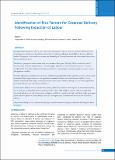Please use this identifier to cite or link to this item:
https://hdl.handle.net/20.500.14356/1800Full metadata record
| DC Field | Value | Language |
|---|---|---|
| dc.contributor.author | Rijal, P | - |
| dc.date.accessioned | 2023-05-23T06:33:45Z | - |
| dc.date.available | 2023-05-23T06:33:45Z | - |
| dc.date.issued | 2014 | - |
| dc.identifier.citation | RijalP. (2014). Identiï¬ cation of Risk Factors for Cesarean Delivery Following Induction of Labour. Journal of Nepal Health Research Council. https://doi.org/10.33314/jnhrc.v0i0.492 | en_US |
| dc.identifier.issn | Print ISSN: 1727-5482; Online ISSN: 1999-6217 | - |
| dc.identifier.uri | http://103.69.126.140:8080/handle/20.500.14356/1800 | - |
| dc.description | Original Article | en_US |
| dc.description.abstract | Abstract Background: Induction of labor is one of the most common procedures in obstetrics. Induction has been found to both increase and decrease the risk of cesarean delivery. Various studies have found different factors in different studies. The purpose of this study is to increase our knowledge of factors that increase risk of cesarean delivery when labour is induced at term. Methods: A prospective observational study was conducted from June 2006-July 2007 at an obstetric unit of Eastern Nepal. A total of 348 patients in a 1:1 ratio (vaginal delivered n1-174, cesarean delivered n2-174) were enrolled in the study after inclusion and exclusion criteria were met. Logistic regression analysis was done to assess the significant variables. Results: Maternal age, height, parity, indication of induction, gestational period at induction, presence of meconium in amniotic fluid, hypertension were not significantly associated with increased risk of cesarean delivery. In an adjusted model only birth weight, prolonged latent and active phases of labour, Bishop’s score =5 were significantly associated with increased risk of cesarean delivery. Conclusions: Bishop’s score =5 at induction, obesity, three doses of misoprostol required for successful induction, use of oxytocin, prolonged latent phase, prolonged active phase, birth weight of neonate >4kg was significantly associated with increased risk of cesarean in unadjusted model but in an adjusted model only birth weight, prolonged latent and active phases of labour, Bishop’s score =5 were significantly associated with increased risk of cesarean delivery.  Keywords: Bishop’s score; cesarean delivery; hypertensive disorders of pregancy; induction of labour; post dated pregnancy. | en_US |
| dc.language.iso | en | en_US |
| dc.publisher | Nepal Health Research Council | en_US |
| dc.relation.ispartofseries | May-Aug, 2014;492 | - |
| dc.subject | Bishop’s score | en_US |
| dc.subject | Cesarean delivery | en_US |
| dc.subject | Hypertensive disorders of pregancy | en_US |
| dc.subject | Induction of labour | en_US |
| dc.subject | Post dated pregnancy | en_US |
| dc.title | Identiï¬ cation of Risk Factors for Cesarean Delivery Following Induction of Labour | en_US |
| dc.type | Journal Article | en_US |
| local.journal.category | Original Article | - |
| Appears in Collections: | Vol. 12 No. 2 Issue 27, May - Aug 2014 | |
Files in This Item:
| File | Description | Size | Format | |
|---|---|---|---|---|
| 492-Article Text-749-2-10-20180205.pdf | Fulltext Download | 220.81 kB | Adobe PDF |  View/Open |
Items in DSpace are protected by copyright, with all rights reserved, unless otherwise indicated.
